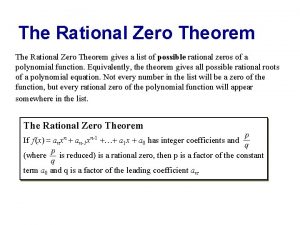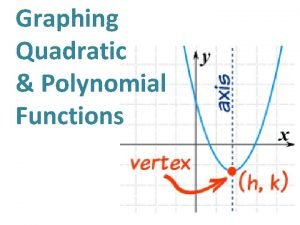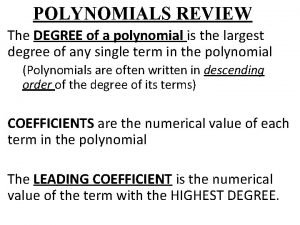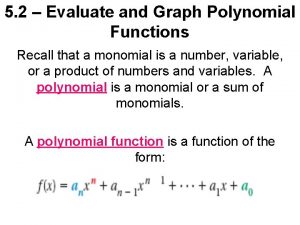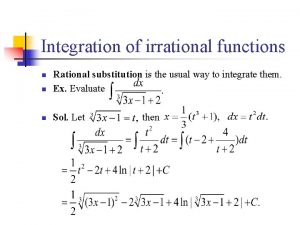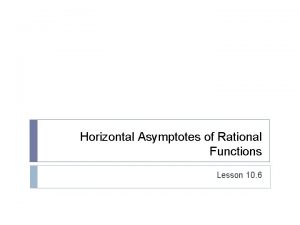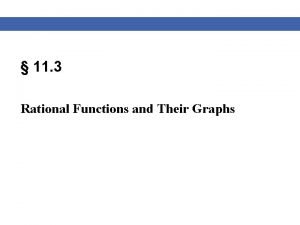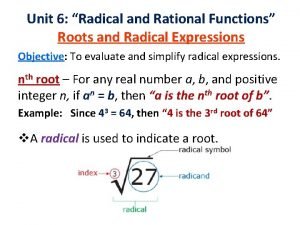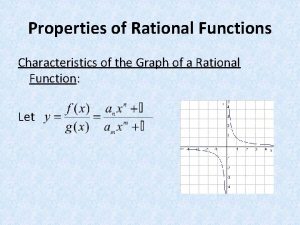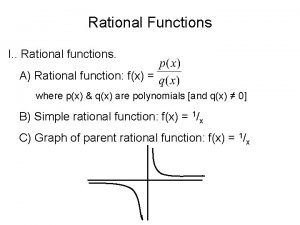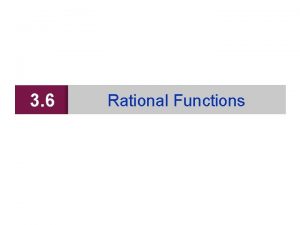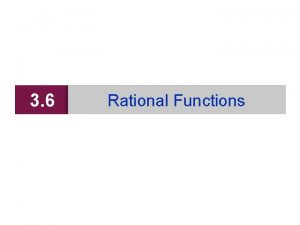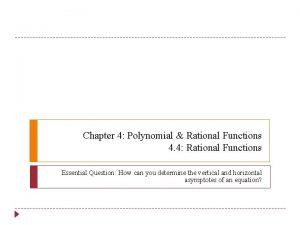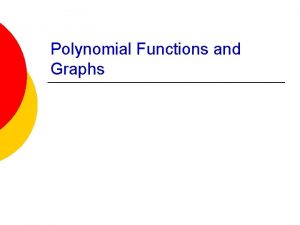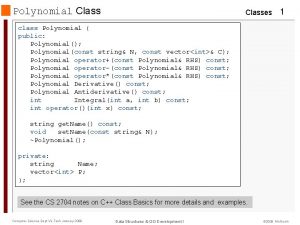CHAPTER 4 Polynomial and Rational Functions 4 1

























- Slides: 25


CHAPTER 4: Polynomial and Rational Functions 4. 1 Polynomial Functions and Models 4. 2 Graphing Polynomial Functions 4. 3 Polynomial Division; The Remainder and Factor Theorems 4. 4 Theorems about Zeros of Polynomial Functions 4. 5 Rational Functions 4. 6 Polynomial and Rational Inequalities Copyright © 2009 Pearson Education, Inc.

4. 5 Rational Functions · For a rational function, find the domain and graph the function, identifying all of the asymptotes. · Solve applied problems involving rational functions. Copyright © 2009 Pearson Education, Inc.

Rational Function A rational function is a function f that is a quotient of two polynomials, that is, where p(x) and q(x) are polynomials and where q(x) is not the zero polynomial. The domain of f consists of all inputs x for which q(x) 0. Copyright © 2009 Pearson Education, Inc. Slide 4. 5 -4

Example Consider . Find the domain and graph f. The graph of the function is the graph of y = 1/x translated to the left 4 units. Solution: When the denominator x + 4 = 0, we have x = 4, so the only input that results in a denominator of 0 is 4. Thus the domain is {x|x 4} or ( , 4) ( 4, ). Copyright © 2009 Pearson Education, Inc. Slide 4. 5 -5

Vertical Asymptotes The vertical asymptotes of a rational function f(x) = p(x)/q(x) are found by determining the zeros of q(x) that are not also zeros of p(x). If p(x) and q(x) are polynomials with no common factors other than constants, we need to determine only the zeros of the denominator q(x). If a is a zero of the denominator but not the numerator, then the line x = a is a vertical asymptote for the graph of the function. Copyright © 2009 Pearson Education, Inc. Slide 4. 5 -6

Example Determine the vertical asymptotes of the function. Factor to find the zeros of the denominator: x 2 4 = (x + 2)(x 2) Thus the vertical asymptotes are the lines x = 2 and x = 2. Copyright © 2009 Pearson Education, Inc. Slide 4. 5 -7

Horizontal Asymptote The line y = b is a horizontal asymptote for the graph of f if either or both of the following are true: When the numerator and the denominator of a rational function have the same degree, the line y = a/b is the horizontal asymptote, where a and b are the leading coefficients of the numerator and the denominator, respectively. Copyright © 2009 Pearson Education, Inc. Slide 4. 5 -8

Horizontal Asymptote Example: Find the horizontal asymptote: The numerator and denominator have the same degree. The ratio of the leading coefficients is 6/9, so the line y = 2/3 is the horizontal asymptote. Copyright © 2009 Pearson Education, Inc. Slide 4. 5 -9

Determining a Horizontal Asymptote • • • When the numerator and the denominator of a rational function have the same degree, the line y = a/b is the horizontal asymptote, where a and b are the leading coefficients of the numerator and the denominator, respectively. When the degree of the numerator of a rational function is less than the degree of the denominator, the x-axis, or y = 0, is the horizontal asymptote. When the degree of the numerator of a rational function is greater than the degree of the denominator, there is no horizontal asymptote. Copyright © 2009 Pearson Education, Inc. Slide 4. 5 -10

True Statements • The graph of a rational function never crosses a vertical asymptote. • The graph of a rational function might cross a horizontal asymptote but does not necessarily do so. Copyright © 2009 Pearson Education, Inc. Slide 4. 5 -11

Example Graph Vertical asymptotes: x + 3 = 0, so x = 3. The degree of the numerator and denominator is the same. Thus y = 2, is the horizontal asymptote. 1. Draw the asymptotes with dashed lines. 2. Compute and plot some ordered pairs and draw the curve. Copyright © 2009 Pearson Education, Inc. Slide 4. 5 -12

Example continued x 7 5 4 2 0 2 h(x) 3. 5 5 8 4 0 4/5 Copyright © 2009 Pearson Education, Inc. Slide 4. 5 -13

Oblique or Slant Asymptote Find all the asymptotes of . The line x = 2 is a vertical asymptote. There is no horizontal asymptote because the degree of the numerator is greater than the degree of the denominator. Note that Copyright © 2009 Pearson Education, Inc. Slide 4. 5 -14

Oblique or Slant Asymptote continued Divide to find an equivalent expression. Copyright © 2009 Pearson Education, Inc. The line y = 2 x 1 is an oblique asymptote. Slide 4. 5 -15

Occurrence of Lines as Asymptotes of Rational Functions • • • For a rational function f(x) = p(x)/q(x), where p(x) and q(x) have no common factors other than constants: Vertical asymptotes occur at any x-values that make the denominator 0. The x-axis is the horizontal asymptote when the degree of the numerator is less than the degree of the denominator. A horizontal asymptote other than the x-axis occurs when the numerator and the denominator have the same degree. Copyright © 2009 Pearson Education, Inc. Slide 4. 5 -16

Occurrence of Lines as Asymptotes of Rational Functions continued • • • An oblique asymptote occurs when the degree of the numerator is 1 greater than the degree of the denominator. There can be only one horizontal asymptote or one oblique asymptote and never both. An asymptote is not part of the graph of the function. Copyright © 2009 Pearson Education, Inc. Slide 4. 5 -17

Graphing Rational Functions 1. Find the real zeros of the denominator. Determine the domain of the function and sketch any vertical asymptotes. 2. Find the horizontal or oblique asymptote, if there is one, and sketch it. 3. Find the zeros of the function. The zeros are found by determining the zeros of the numerator. These are the first coordinates of the x-intercepts of the graph. 4. Find f (0). This gives the y-intercept (0, f (0)), of the function. 5. Find other function values to determine the general shape. Then draw the graph. Copyright © 2009 Pearson Education, Inc. Slide 4. 5 -18

Example Graph 1. Find the zeros by solving: The zeros are 1/2 and 3, thus the domain excludes these values. The graph has vertical asymptotes at x = 3 and x = 1/2. We sketch these with dashed lines. 2. Because the degree of the numerator is less than the degree of the denominator, the x-axis, y = 0, is the horizontal asymptote. Copyright © 2009 Pearson Education, Inc. Slide 4. 5 -19

Example continued 3. To find the zeros of the numerator, we solve x + 3 = 0 and get x = 3. Thus, 3 is the zero of the function, and the pair ( 3, 0) is the x-intercept. 4. We find f(0): Thus (0, 1) is the y-intercept. Copyright © 2009 Pearson Education, Inc. Slide 4. 5 -20

Example continued 5. We find other function values to determine the general shape of the graph and then draw the graph. x f(x) 1 1/2 1 2/3 2 1 4 7/9 Copyright © 2009 Pearson Education, Inc. Slide 4. 5 -21

More Examples Graph the following functions. a) b) c) Copyright © 2009 Pearson Education, Inc. Slide 4. 5 -22

Graph a 1. Vertical Asymptote x = 2 2. Horizontal Asymptote y=1 3. x-intercept (3, 0) 4. y-intercept (0, 3/2) Copyright © 2009 Pearson Education, Inc. Slide 4. 5 -23

Graph b 1. Vertical Asymptote x = 3, x = 3 2. Horizontal Asymptote y = 1 3. x-intercepts ( 2. 828, 0) 4. y-intercept (0, 8/9) Copyright © 2009 Pearson Education, Inc. Slide 4. 5 -24

Graph c 1. Vertical Asymptote x = 1 2. Oblique Asymptote y = x 1 3. x-intercept (0, 0) 4. y-intercept (0, 0) Copyright © 2009 Pearson Education, Inc. Slide 4. 5 -25
 Chapter 4 polynomial and rational functions
Chapter 4 polynomial and rational functions Chapter 3 polynomial and rational functions
Chapter 3 polynomial and rational functions Chapter 3 polynomial and rational functions
Chapter 3 polynomial and rational functions End behavior of a function chart
End behavior of a function chart Solving rational equations and inequalities
Solving rational equations and inequalities Numpy.polynomial.polynomial
Numpy.polynomial.polynomial How to divide a polynomial by another polynomial
How to divide a polynomial by another polynomial Rational zero theorem formula
Rational zero theorem formula Tux robot
Tux robot Graphing of polynomial function
Graphing of polynomial function Review graphing polynomials
Review graphing polynomials Structure in graphs of polynomial functions
Structure in graphs of polynomial functions Evaluate and graph polynomial functions
Evaluate and graph polynomial functions Polynomial functions and their graphs
Polynomial functions and their graphs Polynomial functions and their graphs
Polynomial functions and their graphs Rational function vertical and horizontal asymptotes
Rational function vertical and horizontal asymptotes Rational expressions and functions
Rational expressions and functions Radical functions and rational exponents practice
Radical functions and rational exponents practice Horizontal asymptote rule
Horizontal asymptote rule Irrational function definition
Irrational function definition Rational functions holes and asymptotes
Rational functions holes and asymptotes Vertical answer
Vertical answer Algebra 2 unit 6 radical functions quiz 6-1 answers
Algebra 2 unit 6 radical functions quiz 6-1 answers Rational functions and their graphs
Rational functions and their graphs Unit 6 radical functions homework 3
Unit 6 radical functions homework 3 Rational function characteristics
Rational function characteristics







